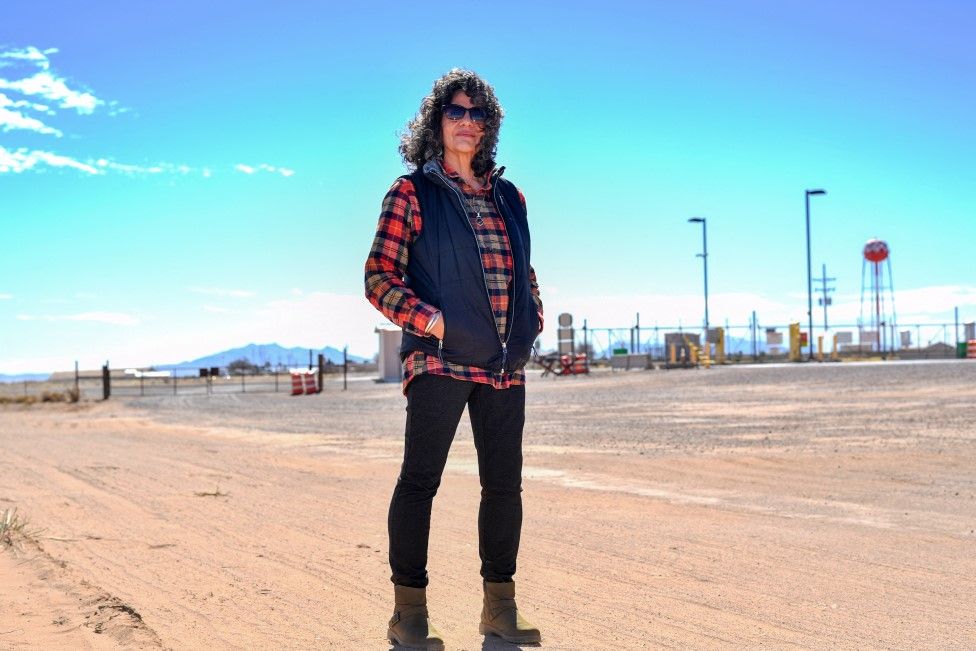ARTICLE AD BOX
 Image source, Getty Images
Image source, Getty Images
Tina Cordova
By Emma Vardy & Sam Granville
BBC News, New Mexico
The success of the film Oppenheimer has shone a spotlight on the work done by scientists in New Mexico as they developed the first nuclear bomb. But 80 years later, some local people say their story remains untold.
"Both my great grandfathers had cancer, my two grandmothers had cancer, my father had three different cancers, my sister has cancer," Tina Cordova says mournfully as she flicks through an old family photo album in her living room.
"I've lost count of the aunts and uncles and cousins who've had cancer. And my family is not unique."
Ms Cordova lives in Albuquerque, about a two-hour drive from where the atomic bomb was developed.
She's one of the "Downwinders," a term used to describe the communities who claim to have been affected by radiation from the Trinity Test, which was the world's first detonation of a nuclear weapon in the New Mexican desert.
The test is the centrepiece of Christopher Nolan's box office hit, Oppenheimer, which follows the physicist of the same name and his team of scientists and engineers who rushed to develop this bomb.
The movie, which is expected to win more awards at the Oscars this Sunday, examines the moral struggles of the men and women who changed the world with the work they did in the desert under a cloak of secrecy.
But Ms Cordova says the film reveals nothing of the legacy of the atomic bomb she says her family have been living with for generations.
The detonation is a memorable moment in the film, as scientists are handed dark glasses and gather on a breezy night to watch their theories and calculations become reality.
Image source, Alamy
Image caption,Cillian Murphy as J Robert Oppenheimer seeing the test explosion
But carried on the wind, according to Ms Cordova, were unforeseen consequences.
"We firmly believe we have been over exposed to radiation during the Trinity bomb, and then also during the bombs that were detonated at Nevada," says Ms Cordova, who was diagnosed with thyroid cancer at the age of 39. Her 23-year-old niece has the same diagnosis.
Cancer is the second leading cause of death in the United States. While a link between radiation exposure and cancer has not been proven conclusively, Ms Cordova has documented hundreds of families with high rates of illness across multiple generations.
One of them is Paul Pino who says the penny dropped when he attended Ms Cordova's presentation about the radiation several years ago. "It was a brutal realisation that came down on us like an avalanche," he recalls.
His family lived 35 miles from the Trinity Test location, and like Ms Cordova, several relatives have been wiped out from cancer. His brother died of stomach cancer and his mother of bone cancer. His sister has thyroid cancer, his daughter had skin cancer and two of his aunts had brain tumours.
The US government has established compensation funds for people in areas where tests happened in later years but New Mexico has not yet been included. That could now change.
Image source, Getty Images
Image caption,Inspection team at Ground Zero, Trinity Test in 1945
An extension to the Radiation Exposure Compensation Act Expansion that would include the Downwinders of New Mexico is set to expire in June. This week the Senate passed the bill in a bipartisan vote. It now goes to the House of Representatives, and the Biden administration has previously indicated support for the passage of the bill.
When the atomic bomb was used on Japan, it effectively ended World War II. The death toll weighs heavily on Oppenheimer's conscience in the movie but the potential risks to people closer to home is a storyline that was not explored.
"They [the filmmakers] never gave any acknowledgement to the sacrifice or suffering of the people of New Mexico," says Ms Cordova regretfully.
Elsewhere in the state, the film is viewed less negatively, particularly in Los Alamos, the secret city where Oppenheimer's team of scientists carried out their work.
For residents there, it's not the history the film lays bare that's being talked about but its impact on the economy.
"Our little town has been turned upside down," says Todd Nickols whose parents were scientists. "We are inundated with a lot more visitors:"
The location of Los Alamos is dramatic, beautiful and remote. The red rock plateaus meet big blue skies for as far as the eye can see. It's a place for the country's best brains to free their imaginations and make scientific breakthroughs, away from prying eyes and distractions.
"My father was a nuclear physicist, and my mother was a geneticist," says Mr Nickols. "And this was just a great wonderful place to grow up. We are proud of the science, proud of the technology."
The name of Oppenheimer is inescapable in the town. There's Oppenheimer Drive, Oppenheimer's statue and several Oppenheimer murals. Many of the local residents of Los Alamos were also extras in the movie.
Image source, Getty Images
Image caption,Oppenheimer merchandise in the Los Alamos Museum store
"We are certainly not glorifying the bomb deaths by any means because it was a horrible, horrible situation," says Mr Nickols. "But World War Two was also horrible."
Today, scientists at Los Alamos still play a key role in making the components for nuclear warheads. As the US government updates its weapons, the lab has been ramping up production.
If you were to stop a random person in the street and address them as "Dr" you probably wouldn't be far wrong. Los Alamos residents have the highest number of PhDs per capita in the country.
"My grandfather worked at the lab, my mother worked at the lab, in fact I'm the first person in my family in three generations to not work at the lab," says Gerald Burns, who is pulling pints in a bar which serves a beer called Hoppenheimer.
The film has clearly been good for business - the bar sells T-shirts with images of Oppenheimer on them with the tag-line "no science, no beer". But what about the moral aspect behind what all this symbolises?
"We have a very nuanced and balanced view of that," he says. "We do have to have respect and regard for when things go wrong, or when things are used as a weapon."
Others take a different view. Back in Albuquerque a small group of anti-war campaigners have gathered to hold a weekend protest about the continuing work in Los Alamos. "Say no to nukes!" say the placards. "Ban the bomb." Their leaflets decry the US using the lab there to renew a nuclear arms race.
As the Oscars ceremony looms, Ms Cordova hopes the buzz around the film will shine a light on the health risks she says are clear and real.
Without the people of New Mexico, there would have been no research project and no Oppenheimer movie, she says.
"I say shame on them. They had an opportunity to actually do something really amazing."

 10 months ago
80
10 months ago
80








 English (US) ·
English (US) ·